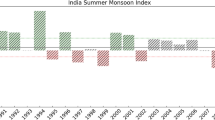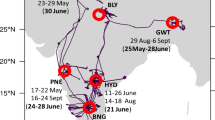Abstract
In order to improve our understanding of microphysical properties of clouds and precipitation over the Tibetan Plateau (TP), six cloud and precipitation processes with different intensities during the Third Tibetan Plateau Atmospheric Science Experiment (TIPEX-III) from 3 July to 25 July 2014 in Naqu region of the TP are investigated by using the high-resolution mesoscale Weather Research and Forecasting (WRF) model. The results show unique properties of summertime clouds and precipitation processes over the TP. The initiation process of clouds is closely associated with strong solar radiative heating in the daytime, and summertime clouds and precipitation show an obvious diurnal variation. Generally, convective clouds would transform into stratiform clouds with an obvious bright band and often produce strong rainfall in midnight. The maximum cloud top can reach more than 15 km above sea level and the velocity of updraft ranges from 10 to 40 m s−1. The simulations show high amount of supercooled water content primarily located between 0 and −20°C layer in all the six cases. Ice crystals mainly form above the level of −20°C and even appear above the level of −40°C within strong convective clouds. Rainwater mostly appears below the melting layer, indicating that its formation mainly depends on the melting process of precipitable ice particles. Snow and graupel particles have the characteristics of high content and deep vertical distribution, showing that the ice phase process is very active in the development of clouds and precipitation. The conversion and formation of hydrometeors and precipitation over the plateau exhibit obvious characteristics. Surface precipitation is mainly formed by the melting of graupel particles. Although the warm cloud microphysical process has less direct contribution to the formation of surface precipitation, it is important for the formation of supercooled raindrops, which are essential for the formation of graupel embryos through heterogeneous freezing process. The growth of graupel particles mainly relies on the riming process with supercooled cloud water and aggregation of snow particles.
Similar content being viewed by others
References
Bhatt, B. C., and K. Nakamura, 2005: Characteristics of monsoon rainfall around the Himalayas revealed by TRMM precipitation radar. Mon. Wea. Rev., 133, 149–165, DOI: https://doi.org/10.1175/MWR-2846.1.
Chang, Y., and X. L. Guo, 2016: Characteristics of convective cloud and precipitation during summer time at Naqu over Tibetan Plateau. Chinese Sci. Bull., 61, 1706–1720, DOI: https://doi.org/10.1360/N972015-01292. (in Chinese)
Chen, F., and J. Dudhia, 2001: Coupling an advanced land-surface/hydrology model with the Penn State/NCAR MM5 modeling system. Part I: Model description and implementation. Mon. Wea. Rev., 129, 569–585, DOI: https://doi.org/10.1175/15200493(2001)129<0569:CAALSH>2.0.CO;2.
Dudhia, J., 1989: Numerical study of convection observed during the winter monsoon experiment using a mesoscale two-dimensional model. J. Atmos. Sci., 46, 3077–3107, DOI: https://doi.org/10.1175/1520-0469(1989)046<3077:NSOCOD>2.0.CO;2.
Fu, Y. F., G. S. Liu, G. X. Wu, et al., 2006: Tower mast of precipitation over the central Tibetan Plateau summer. Geophys. Res. Lett., 33, L05802, DOI: https://doi.org/10.1029/2005GL024713.
Fu, Y. F., H. T. Li, and Y. Zi, 2007: Case study of precipitation cloud structure viewed by TRMM satellite in a valley of the Tibetan Plateau. Plateau Meteor., 26, 98–106. (in Chinese)
Fu, Y. F., Q. Liu, Y. Zi, et al., 2008: Summer precipitation and latent heating over the Tibetan Plateau based on TRMM measurements. Plateau Mountain Meteor. Res., 28, 8–18, DOI: https://doi.org/10.1659/mrd.0969. (in Chinese)
Fujinami, H., and T. Yasunari, 2001: The seasonal and intraseasonal variability of diurnal cloud activity over the Tibetan Plateau. J. Meteor. Soc. Japan, 79, 1207–1227, DOI: https://doi.org/10.2151/jmsj.79.1207.
Fujinami, H., S. Nomura, and T. Yasunari, 2005: Characteristics of diurnal variations in convection and precipitation over the southern Tibetan Plateau during summer. SOLA, 1, 49–52, DOI: https://doi.org/10.2151/sola.2005-014.
Gao, W. H., C. H. Sui, J. W. Fan, et al., 2016: A study of cloud microphysics and precipitation over the Tibetan Plateau by radar observations and cloud-resolving model simulations. J. Geophys. Res. Atmos., 121, 13735–13752, DOI: https://doi.org/10.1002/2015JD024196.
Gao, W. H., L. P. Liu, J. Li, et al., 2018: The microphysical properties of convective precipitation over the Tibetan Plateau by a subkilometer resolution cloud-resolving simulation. J. Geophys. Res. Atmos., 233, 3212–3227, DOI: https://doi.org/10.1022/0017JD027812.
Grell, G., and D. Devenyi, 2002: A generalized approach to parameterizing convection combining ensemble and data assimilation techniques. Geophys. Res. Lett., 29, 1693, DOI: https://doi.org/10.1029/2002GL015311.
Haginoya, S., H. Fujii, T. Kuwagata, et al., 2009: Air-lake interaction features found in heat and water exchanges over Nam Co on the Tibetan Plateau. SOLA, 5, 172–175, DOI: https://doi.org/10.2151/sola.2009-044.
Janjic, Z. I., 2002: Nonsingular implementation of the Mellor-Yamada level 2.5 scheme in the NCEP meso model. NECP Office Note, No. 437, 61 pp.
Kurosaki, Y., and F. Kimura, 2002: Relationship between topography and daytime cloud activity around Tibetan Plateau. J. Meteor. Soc. Japan, 80, 1339–1355, DOI: https://doi.org/10.2151/jmsj.80.1339.
Li, M., Y. Ma, Z. Hu, et al., 2009: Snow distribution over the Namco lake area of the Tibetan Plateau. Hydrol. Earth Syst. Sci., 13, 2023–2030, DOI: https://doi.org/10.5194/hess-13-2023-2009.
Li, D., A. J. Bai, and S. J. Huang, 2012: Characteristic analysis of a severe convective weather over Tibetan Plateau based on TRMM data. Plateau Meteor., 31, 304–311. (in Chinese)
Li, Y. Y., and M. H. Zhang, 2016: Cumulus over the Tibetan Plateau in the summer based on CloudSat-CALIPSO data. J. Climate, 29, 1219–1230, DOI: https://doi.org/10.1175/JCLI-D-15-0492.1.
Lin, Y. L., R. D. Farley, and H. D. Orville, 1983: Bulk parameterization of the snow field in a cloud model. J. Climate Appl. Meteor., 22, 1065–1092, DOI: https://doi.org/10.1175/1500-4400(1833)022<1065:BPOTSF>2.0.CO;2.
Liu, L. P., R. Z. Chu, X. M. Song, et al., 1999: Summary and preliminary results of cloud and precipitation observation in Qinghai-Xizang Plateau in GAME-TIBET. Plateau Meteor., 18, 441–450. (in Chinese)
Liu, L. P., J. M. Feng, R. Z. Chu, et al., 2002: The diurnal variation of precipitation in monsoon season in the Tibetan Plateau. Adv. Atmos. Sci., 19, 365–378, DOI: https://doi.org/10.1007/s00376-0020028-6.
Liu, L. P., J. F. Zheng, Z. Ruan, et al., 2015: Comprehensive radar observations of clouds and precipitation over the Tibetan Plateau and preliminary analysis of cloud properties. J. Meteor. Res., 29, 546–561, DOI: https://doi.org/10.1007/s13351-015-4208-6.
Maussion, F., D. Scherer, R. Finkelnburg, et al., 2011: WRF simulation of a precipitation event over the Tibetan Plateau, China—an assessment using remote sensing and ground observations. Hydrol. Earth Syst. Sci., 15, 1795–1817, DOI: https://doi.org/10.5194/hess-15-1795-2011.
Mlawer, E., S. Taubman, P. Brown, et al., 1997: Radiative transfer for inhomogeneous atmospheres: RRTM, a validated correlated-k model for the longwave. J. Geophys. Res. Atmos., 102, 16663, DOI: https://doi.org/10.1029/97JD00237.
Pan, X., and Y. F. Fu, 2015: Analysis on climatological characteristics of deep and shallow precipitation cloud in summer over Qinghai-Xizang Plateau. Plateau Meteor., 34, 1191–1203. (in Chinese)
Qiao, Q. M., and Y. G. Zhang, 1994: Tibetan Plateau Weather. China Meteorological Press, Beijing, 45–16. (in Chinese)
Sato, T., T. Yoshikane, M. Satoh, et al., 2008: Resolution dependency of the diurnal cycle of convective clouds over the Tibetan Plateau in a mesoscale model. J. Meteor. Soc. Japan, 86A, 17–31, DOI: https://doi.org/10.2151/jmsj.86A.17.
Shen, Y., P. Zhao, Y. Pan, et al., 2014: A high spatiotemporal gauge-satellite merged precipitation analysis over China. J. Geophys. Res. Atmos., 119, 3063–3075, DOI: https://doi.org/10.1002/2013JD020686.
Shi, Y. Q., X. F. Lou, X. J. Deng, et al., 2008: Simulations of mesoscale and microphysical characteristics of cold front clouds in South China. Chinese J. Atmos. Sci., 32, 1019–1036. (in Chinese)
Sugimoto, S., and K. Ueno, 2010: Formation of mesoscale convective systems over the eastern Tibetan Plateau affected by plateau-scale heating contrasts. J. Geophys. Res. Atmos., 115, D16105, DOI: https://doi.org/10.1029/2009JD013609.
Ueno, K., H. Fujii, H. Yamada, et al., 2001: Weak and frequent monsoon precipitation over the Tibetan Plateau. J. Meteor. Soc. Japan, 79, 419–434, DOI: https://doi.org/10.2151/jmsj.79.419.
Uyeda, H., H. Yamada, J. Horikomi, et al., 2001: Characteristics of convective clouds observed by a Doppler radar at Naqu on Tibetan Plateau during the GAME-Tibet IOP. J. Meteor. Soc. Japan, 79, 463–474, DOI: https://doi.org/10.2151/jmsj.79.463.
Xu, J. Y., B. Zhang, M. H. Wang, et al., 2012: Diurnal variation of summer precipitation over the Tibetan Plateau: A cloud-resolving simulation. Ann. Geophys., 30, 1575–1586, DOI: https://doi.org/10.5194/angeo-30-1575-2012.
Xu, X. D., and L. S. Chen, 2006: Advances of the study on Tibetan Plateau experiment of atmospheric sciences. J. Appl. Meteor. Sci., 17, 756–772. (in Chinese)
Xu, X. D., M. Y. Zhou, J. Y. Chen, et al., 2002: A comprehensive physical pattern of land-air dynamic and thermal structure on the Qinghai-Xizang Plateau. Sci. China Earth Sci., 45, 577–594, DOI: https://doi.org/10.1360/02yd9060.
Xu, X. D., T. L. Zhao, C. G. Lu, et al., 2014: Characteristics of the water cycle in the atmosphere over the Tibetan Plateau. Acta Meteor. Sinica, 72, 1079–1095. (in Chinese)
Yu, R. C., J. Li, Y. Zhang, et al., 2015: Improvement of rainfall simulation on the steep edge of the Tibetan Plateau by using a finite-difference transport scheme in CAM5. Climate Dyn., 45, 2937–2948, DOI: https://doi.org/10.1007/s00382-015-2515-3.
Zhu, G. F., and S. J. Chen, 2003: Analysis and comparison of mesoscale convective systems over the Qinghai-Xizang (Tibetan) Plateau. Adv. Atmos. Sci, 20, 311–322, DOI: https://doi.org/10.1007/BF032690789.
Zhu, S. C., Y. Yin, L. J. Jin, et al., 2011: A numerical study of the vertical transport of water vapor by intense convection over the Tibetan Plateau. Chinese J. Atmos. Sci., 35, 1057–1068. (in Chinese)
Author information
Authors and Affiliations
Corresponding author
Additional information
Supported by the China Meteorological Administration Special Public Welfare Research Fund for the Third Tibetan Plateau Atmospheric Science Experiment (GYHY201406001) and Second Tibetan Plateau Scientific Expedition and Research (STEP) Program of Chinese Academy of Sciences (2019QZKK0104).
Rights and permissions
About this article
Cite this article
Tang, J., Guo, X. & Chang, Y. A Numerical Investigation on Microphysical Properties of Clouds and Precipitation over the Tibetan Plateau in Summer 2014. J Meteorol Res 33, 463–477 (2019). https://doi.org/10.1007/s13351-019-8614-z
Received:
Accepted:
Published:
Issue Date:
DOI: https://doi.org/10.1007/s13351-019-8614-z




